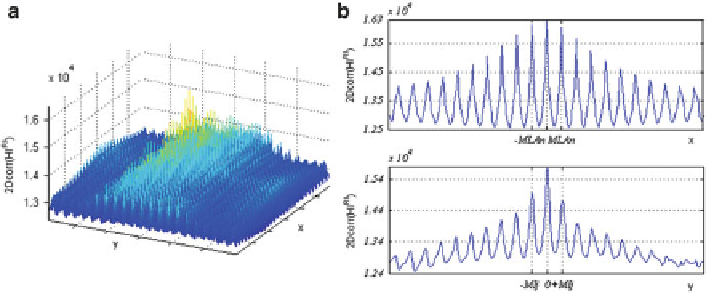Image Processing Reference
In-Depth Information
Fig. 5.8 Example of spatial correlation in a RI-based holoscopic image: (a) autocorrelation
function; and (b) projection onto x and y axis
5.3.4
2D and Multiview Content Generation
Generating 2D and 3D multiview content from 3D holoscopic content means
producing various 2D views with different viewing angles. Two algorithms pro-
posed in [
7
] and referred to as Basic Rendering and Weighted Blending are briefly
described, as follows. More details can be also found in [
7
].
5.3.4.1 Basic Rendering Algorithm
Since each micro-image can be seen as a low resolution view of the scene, it is
possible to choose suitable portions from each micro-image to stitch and then
compose a 2D view image. This is the basis for the Basic Rendering algorithm.
The input for this algorithm is a 3D holoscopic image (Fig.
5.9a
) with an
MLA
n
MLA
m
array of micro-images, where each micro-image has a resolution
of MI
j
PS pixels is
extracted from each micro-image. These patches are then stitched together, as
illustrated in Fig.
5.9b
. As a result, the output is a 2D view image with a resolution
of (PS
MI
i
. In this 3D holoscopic image, a portion (patch) of PS
MLA
n
)
(PS
MLA
m
).
5.3.4.2 Weighted Blending Algorithm
To avoid some blocky artifacts due to a non-perfect match between the patches with
fixed size in the Basic Rendering algorithm, an alternative algorithm was proposed
in [
7
] and is also considered here for 2D views generation. The main idea is to
smooth these artifacts with a weighted blending algorithm.

